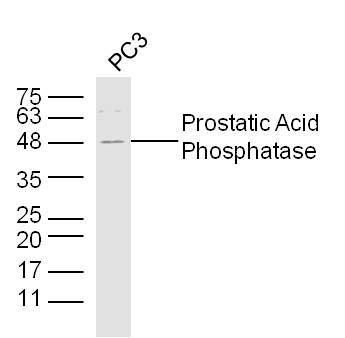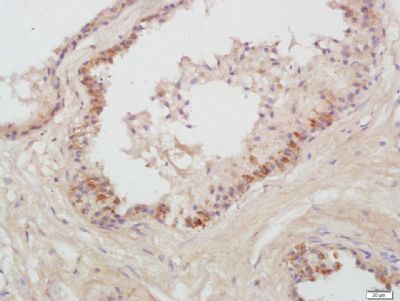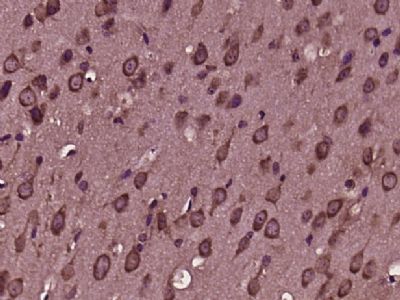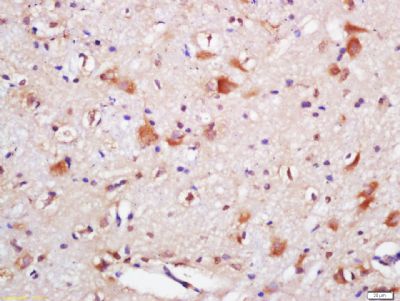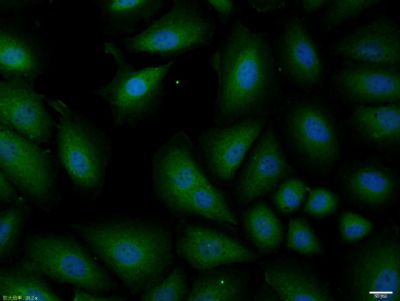[IF=2.751] Jiachen Lv. et al. Alcohol Aggravates Acute Pancreatitis by Impairing Autophagic Flux Through Activation of AMPK Signaling Pathway. 2021 Feb 08 WB,IHC ; Human,Rat.
[IF=1.698] Sheng-Tao Ling. et al. Hydroxychloroquine Blocks Autophagy and Promotes Apoptosis of the Prostate after Castration in Rats. Urol Int. 2020;104(11-12):968-974 IHC ; Rat.
[IF=3.067] Kang Z et al. Copper-induced apoptosis and autophagy through oxidative stress-mediated mitochondrial dysfunction in male germ cells. Toxicol In Vitro. 2019 Sep 3;61:104639. WB ; Mouse.
[IF=2.107] Yin X et al. Lithium facilitates removal of misfolded proteins and attenuated faulty interaction between mutant SOD1 and p-CREB (Ser133) through enhanced autophagy in mutant hSOD1G93A transfected neuronal cell lines. Mol Biol Rep. 2019 Sep 16. WB ; Human.
[IF=2.798] Kim J et al. Human β-defensin 2 is involved in CCR2-mediated Nod2 signal transduction, leading to activation of the innate immune response in macrophages. Immunobiology. 2019 May 18. WB ; Human.
[IF=3.68] Yang and Yao JNK-Bcl-2/Bcl-xL-Bax/Bak Pathway Mediates the Crosstalk between Matrine-Induced Autophagy and Apoptosis via Interplay with Beclin 1. (2015) Int.J.Mol.Sci. 16:25744-58 WB ; Human.
[IF=2.82] Cuellar et al. Immunohistochemical Localization of Bone Morphogenetic Proteins (BMPs) and their Receptors in Solitary and Multiple Human Osteochondromas. (2014) J.Histochem.Cytochem. 62:488-498 IHC ; Human.
[IF=2.78] Chen, Yunbo, et al. "β-Asarone prevents autophagy and synaptic loss by reducing ROCK expression in asenescence-accelerated prone 8 mice." Brain research 1552 (2014): 41-54. WB ; Mouse.
[IF=0] Xia, Xj, et al. "Autophagy mediated by arginine depletion activation of the nutrient sensor GCN2 contributes to interferon-γ-induced malignant transformation of primary bovine mammary epithelial cells." Cell Death Discovery 2 (2016). IHSLCP ; Bovine.
[IF=2.19] Cui, Xiaodong, et al. "Changes of intracellular Ca2+ in quercetin-induced autophagy progression." Acta Biochimica et Biophysica Sinica (2015): gmv096. WB ; Human.
[IF=5.74] Kuo, Hsiao-Mei, et al. "Altered Mitochondrial Dynamics and Response to Insulin in Cybrid Cells Harboring a Diabetes-susceptible Mitochondrial DNA Haplogroup." Free Radical Biology and Medicine (2016). WB ; Human.
[IF=15.2] Lovren, Fina, et al. "MicroRNA-145 Targeted Therapy Reduces Atherosclerosis." Circulation 126.11 suppl 1 (2012): S81-S90. IHSLCF ; Mouse.
[IF=2.613] Kong Q et al. Autophagy inhibits TLR4‐mediated invasiveness of oral cancer cells via the NF‐κB pathway. Oral Dis. 2020 Apr 14. WB&Co-IP ; Human.
[IF=3.647] Lin D et al. Aldehyde dehydrogenase 2 regulates autophagy via the Akt-mTOR pathway to mitigate renal ischemia-reperfusion injury in hypothermic machine perfusion. Life Sci
. 2020 Jul 15;253:117705. IHC,WB ; mouse.
[IF=2.613] Kong Q et al. Autophagy Inhibits TLR4‐mediated Invasiveness of Oral cancer Cells Via the NF‐κB Pathway. Oral Dis
. 2020 Apr 14. WB ; human.
[IF=3.414] Ma HX et al. Mu-Xiang-You-Fang protects PC12 cells against OGD/R-induced autophagy via the AMPK/mTOR signaling pathway. J Ethnopharmacol. 2020 Jan 22;252:112583. ICF&WB ; Rattus norvegicus.
[IF=2.819] Wang B et al. Resolvin D1 Resolve Inflammation in Experimental Acute Pancreatitis by Restoring Autophagic Flux.Dig Dis Sci. 2018 Dec;63(12):3359-3366. WB ; Mouse.
[IF=3.166] Wang Q et al. PCB28 and PCB52 induce hepatotoxicity by impairing the autophagic flux and stimulating cell apoptosis in vitro. Toxicol Lett. 2018 Jun 1;289:28-41. WB&IF ; Human &Rat.
[IF=3.257] Wang et al. Blocking autophagic flux enhances matrine-induced apoptosis in human hepatoma cells. (2013) Int.J.Mol.Sc. 14:23212-30 WB ; Human.
